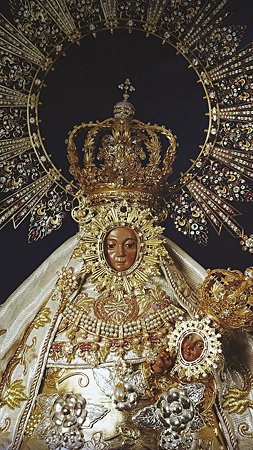Cultural Center of the Philippines
ENCYCLOPEDIA OF
PHILIPPINE ART
Our Lady of Peñafrancia / Nuestra Señora de Peñafrancia / Ina
(Mother) / Early 18th century / Wood / Approximately 91 cm in height / Naga City, Bicol region
The wooden image depicts a crowned Madonna and Child, with the infant Jesus looking toward his mother. The image stands on a silver base and is covered with a silver frontal and a voluminous cloak. A rostrillo (an oval frame of rays) surrounds the face of both the Virgin and the Child (Gorospe and Javellana 1995, 20). The title “Peñafrancia” came from the place Peña de Francia, meaning Rock of France. A Frenchman named Simon Vela was believed to have been sent by a prophetic voice to a rocky mountaintop in Salamanca, Spain, to unearth an image of the Virgin Mary, later known as Peñafrancia. For many Filipino Marian devotees, the title Peñafrancia is almost synonymous to “Mother of Bicolandia” or simply “Ina” (Gorospe and Javellana 1995, 2-3, 30-31). The image was honored with a canonical coronation under Pope Pius XI in 1924 (Santos 1982, 42).
The image of Our Lady of Peñafrancia was commissioned by Fray Miguel Robles de Covarrubias when he was called to serve as rector of the cathedral and vicar general of Nueva Caceres, the Hispanic name of Naga during the early 18th century. Fray Miguel commissioned a local sculptor to carve a wooden image based on his revered picture of the Virgin of Peña de Francia.
Traditional belief has it that the sculptor slaughtered a dog and used its blood to paint the image dark, to emulate the skin tone of the Aeta who dwell in the mountains of the region. However, after being thrown into the Bicol River, the dog reportedly sprang back to life and returned to his master. The story quickly spread across the region, igniting a fiery devotion to the image. This is just the first narrative in a continuously expanding anthology of miracles from devotees (Gorospe and Javellana 1995, 18-19). Alluding to Bicolandia’s mythology of monsters haunting the forests, such as the doglike aswang, the sacrificial dog’s reincarnation was reinterpreted as a sign that the miraculous Virgin had exorcised the land of its fearsome mythical creatures (Santos 1982, 42).
The image was originally enshrined in a chapel built along the banks of the Bicol River. The present shrine was built by Bishop Ysidro Arevalo in 1741 and renovated by Francisco Gainza during the late 19th century to accommodate the growing number of devotees. As the devotion grew even more, a larger church was built on the other side of the river to house the image. This church was elevated to the rank of a minor basilica in 1985 (Gorospe and Javellana 1995, 18-19, 24-25, 82).
The feast of Our Lady of Peñafrancia is celebrated on the third Saturday of September. The novena starts with the traslacion (transfer) where the image of the Virgin along with the image of the Divino Rostro are borne on shoulders of strictly male devotees, the sculpture moving in a wavelike manner with devotees competing to get a chance to touch the image as it is transported from the Minor Basilica to the cathedral. On the eighth day of the novena and as highlight of the festivities, a fluvial procession on the Bicol River is held in the Virgin’s honor. The Peñafrancia festivities draw pilgrims from all parts of the country and serve as annual homecoming event for Bikolanos (Gorospe and Javellana 1995, 38-79).
Written by Dino Carlo S. Santos
Sources
Gorospe, Vitaliano R., and Rene B. Javellana. 1995. Virgin of Peñafrancia: Mother of Bicol. Makati: Vitaliano R. Gorospe, Rene B. Javellana and Bookmark Inc.
Santos, Luz M. 1982. “Nuestra Señora de Peñafrancia.” In Mary in the Philippines, edited by Nick M. Joaquin, 16. Manila: Luz Mendoza
Santos.
